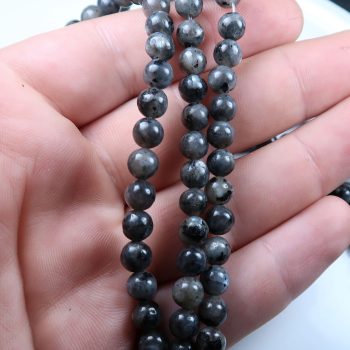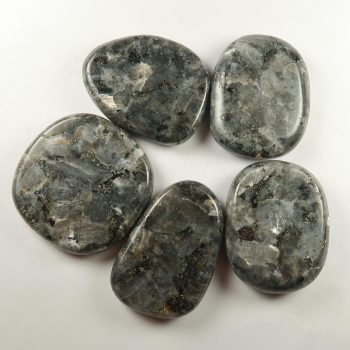Larvikite
Larvikite is a dark mineral with a secret – patches of feldspar causing an effect known as schiller – a flash similar to Labradorite. It is sometimes used as a decorative facade on buildings.
Larvikite is almost always sold polished – when rough, it is not a particularly interesting looking mineral.
Showing all 2 results
-

Larvikite bead strands
Price range: £2.50 through £4.00 -

Larvikite palmstones
Price range: £3.50 through £4.50
Uses and History
Larvikite is an igneous rock with inclusions of Feldspar. It is often polished and used for the facades of commercial buildings, banks, and corporate headquarters – including the Devon Tower, the Bank of America tower, and the Burj-Al-Arab.
Historically, many of the churches around the area of Norway where it is found are made of Larvikite, from the 12th century onwards. It was used in a royal castle in Oslo in the 1820s, and as beach defences during WW2.
Nowadays, it is often used for decorative stonework and for facades, gravestones, and sometimes, jewellery.
Locales
The most important locale for this material is Norway, but it is also found in Canada, France, Mexico, Russia, Ukraine and the United States.
Mineralogy
Hazards and Warnings
Almost all rocks, minerals (and, frankly, almost all other substances on earth) can produce toxic dust when cutting, which can cause serious respiratory conditions including silicosis.
When cutting or polishing rocks, minerals, shells, etc, all work should be done wet to minimise the dust, and a suitable respirator or extraction system should be used.
Translations
Arabic:
Hindi:
Portuguese:
- larvikita
Bengali:
Indonesian:
Punjabi:
English:
Italian:
Russian:
French:
Japanese:
- ラルビカイト
Spanish:
- larvikita
German:
- Larvikit
Korean:
Thai:
Gujurati:
Mandarin and Traditional Chinese:
- 拉维石
Urdu:
